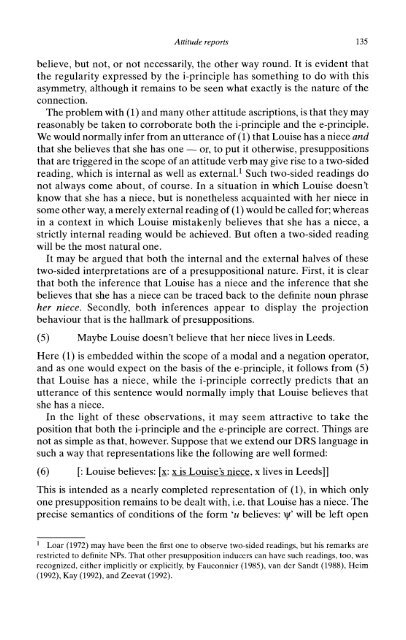Presuppositions and Pronouns - Nijmegen Centre for Semantics
Presuppositions and Pronouns - Nijmegen Centre for Semantics
Presuppositions and Pronouns - Nijmegen Centre for Semantics
You also want an ePaper? Increase the reach of your titles
YUMPU automatically turns print PDFs into web optimized ePapers that Google loves.
Attitude reports 135<br />
believe, but not, or not necessarily, the other way round. It is evident that<br />
the regularity expressed by the i-principle has something to do with this<br />
asymmetry, although it remains to be seen what exactly is the nature of the<br />
connection.<br />
The problem with (1) <strong>and</strong> many other attitude ascriptions, is that they may<br />
reasonably be taken to corroborate both the i-principle <strong>and</strong> the e-principle.<br />
We would normally infer from an utterance of (1) that Louise has a niece <strong>and</strong><br />
that she believes that she has one -— or, to put it otherwise, presuppositions<br />
that are triggered in the scope of an attitude verb may give rise to a two-sided<br />
reading, which is internal as well as external. 1 Such two-sided readings do<br />
not always come about, of course. In a situation in which Louise doesn't<br />
know that she has a niece, but is nonetheless acquainted with her niece in<br />
some other way, a merely external reading of (1) would be called <strong>for</strong>; whereas<br />
in a context in which Louise mistakenly believes that she has a niece, a<br />
strictly internal reading would be achieved. But often a two-sided reading<br />
will be the most natural one.<br />
It may be argued that both the internal <strong>and</strong> the external halves of these<br />
two-sided interpretations are of a presuppositional nature. First, it is clear<br />
that both the inference that Louise has a niece <strong>and</strong> the inference that she<br />
believes that she has a niece can be traced back to the definite noun phrase<br />
her niece. Secondly, both inferences appear to display the projection<br />
behaviour that is the hallmark of presuppositions.<br />
(5) Maybe Louise doesn't believe that her niece lives in Leeds.<br />
Here (1) is embedded within the scope of a modal <strong>and</strong> a negation operator,<br />
<strong>and</strong> as one would expect on the basis of the e-principle, it follows from (5)<br />
that Louise has a niece, while the i-principle correctly predicts that an<br />
utterance of this sentence would normally imply that Louise believes that<br />
she has a niece.<br />
In the light of these observations, it may seem attractive to take the<br />
position that both the i-principle <strong>and</strong> the e-principle are correct. Things are<br />
not as simple as that, however. Suppose that we extend our DRS language in<br />
such a way that representations like the following are well <strong>for</strong>med:<br />
(6) [: Louise believes: [K: [x: x is Louise's niece, x lives in Leeds]]<br />
This is intended as a nearly completed representation of (1), in which only<br />
one presupposition remains to be dealt with, i.e. that Louise has a niece. The<br />
precise semantics of conditions of the <strong>for</strong>m 'u believes: 'If' xj/' will be left open<br />
1 Loar (1972) may have been the first one to observe two-sided readings, but his remarks are<br />
restricted to definite NPs. That other presupposition inducers can have such readings, too, was<br />
recognized, either implicitly or explicitly, by Fauconnier (1985), van der S<strong>and</strong>t (1988), Heim<br />
(1992), Kay (1992), <strong>and</strong> Zeevat (1992).














